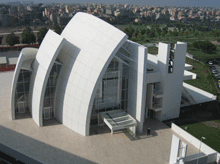After living through decades of Big Dig construction and disruption, the average Bostonian has developed a keener design knowledge and sensitivity. Today, with the Central Artery moving toward the finish line and a number of prominent architectural projects recently completed, in progress, or in the works, we’ve become more informed citizens of the architectural conversation, and in some cases the debate. The Museum of Fine Arts is expanding, the Institute of Contemporary Art is moving to new quarters, and a Museum of the City of Boston has been proposed. Institutional projects at universities and hospitals have added to this building boom.
 Will these projects be appropriate or disharmonious? Will they be physically contentious or heroic or just visually insignificant? Will there be design delight or edifice envy? With new forms being added to old and new architecture, is Boston in danger of losing its physical essence? This essence can be described as a sense of history, a sense of human scale, and a patina of civic livability. Most would agree that Boston should not look like Chicago.
Will these projects be appropriate or disharmonious? Will they be physically contentious or heroic or just visually insignificant? Will there be design delight or edifice envy? With new forms being added to old and new architecture, is Boston in danger of losing its physical essence? This essence can be described as a sense of history, a sense of human scale, and a patina of civic livability. Most would agree that Boston should not look like Chicago.
About 10 years ago, at the Museum of Fine Arts, I saw Judith Pearlman’s Bauhaus in America, part of a film series about architecture and design. Films about Frank Lloyd Wright and other prominent architects have always been well attended at the MFA, but a film on the Bauhaus was something else.
This German school (1919–1933) stressed the unification of art, design, and industry through modernism and functionality. Considered since its inception to be almost a holy grail of design, it has been the subject of many books and articles but few documentaries. The response to the Bauhaus in America was overwhelming: the MFA had to schedule several showings, and more than 1000 people came to see it. According to MFA film and concert program head Bo Smith, it was the first film on art or architecture at the MFA to have repeated showings. And it proved that there was a pent-up demand for design topics.
This makes a lot of sense, since Boston is one of the great centers of design in the US, with a large regenerating community. The graduate programs at Harvard and MIT produce a yearly crop of building architects, landscape architects, and urban designers. There are programs in undergraduate architecture or industrial design at Northeastern, the Boston Architectural Center, Mass College of Art and Wentworth Institute. Graphic design is studied at Boston University, Suffolk University's School of Art and Design, and many other colleges. Architectural firms and design consultancies add to the designer population.
Over the next month, the MFA is presenting a series of nine films documenting the works of important 20th-century architects. Many of these architects are shaping the institutional landscape of Boston. Norman Foster is designing the new American Wing of the Museum of Fine Arts; Diller + Scofidio are creating the new Institute of Contemporary Art; Moshe Safdie designed the Peabody Essex Museum in Salem and will be working on the Museum of the City of Boston; Frank Gehry recently completed the Ray and Maria Stata Center (2004) at MIT. Michael Blackwood has made more than 100 films on art and architecture since the late 1960s; he directed six of the films in the series.
M ajor architects (Frank Gehry suggests that there are perhaps 50 in the world) did not get to be major by being easy-going, loveable individuals. Most have huge egos, are eccentric at best, and often are difficult and even outrageous individuals — except, of course, to their clients. The problems of balancing large-scale creative achievement in a functional world while running a global business somewhat explain the personality difficulties. These documentaries smooth out some hard edges and make their subjects if not likable then at least understandable.
ajor architects (Frank Gehry suggests that there are perhaps 50 in the world) did not get to be major by being easy-going, loveable individuals. Most have huge egos, are eccentric at best, and often are difficult and even outrageous individuals — except, of course, to their clients. The problems of balancing large-scale creative achievement in a functional world while running a global business somewhat explain the personality difficulties. These documentaries smooth out some hard edges and make their subjects if not likable then at least understandable.
Donald Winkler’s Moshe Safdie, the Power of Architecture kicks off the series (January 12 at 8 pm; February 5 at 1:45 pm) with a rather over-warm look at the life and career of the Israeli-born, Canadian-raised American resident whose major office is in Somerville. He achieved fame at an extremely early age (29) by creating the then revolutionary Habitat for Expo ’67 in Montreal. The film follows him through the decades in Israel, Canada, and the United States. Unfortunately, the Peabody Essex Museum, one of his most resolved and beautiful projects, is given short shrift.
Frank Gehry: An Architecture of Joy (January 13 at 5:45 pm; January 21 at 11:30 am) focuses on Gehry's iconoclastic organic sculptured architecture during the 1990s. Visiting key works including his great Guggenheim Museum in Bilbao and projects in Minneapolis and Berlin, Gehry joyfully discusses his approach. The film ends with the preliminary discussions at MIT that eventually resulted in the controversial and over-budget Stata Center.